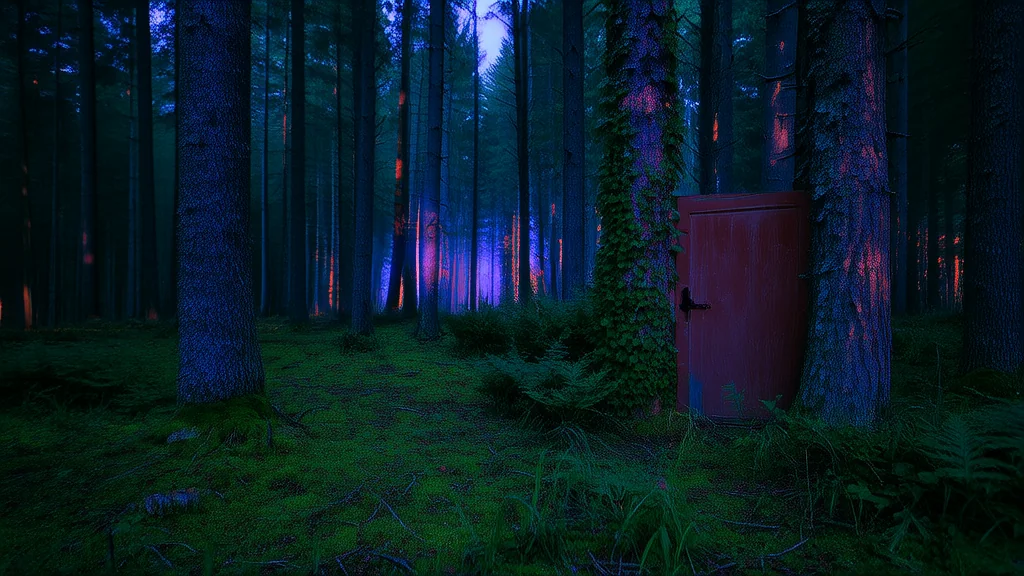🔮 Weird Tales & Urban Legends
The Secret Behind the Red Door in Elmsworth's Forbidden Woods

The town of Elmsworth had always been quiet, a place where the wind whispered through the pines and the old mill by the river creaked like a tired man. No one really knew what happened in the woods beyond the edge of town, but no one ever went there either. The locals spoke of strange lights at night, of shadows that moved without a body to cast them, and of a single red door hidden deep in the trees. It was said that the government had once built something there, something they never wanted anyone to find.
Elias Whitmore was a journalist with a habit of digging too deep. He’d come to Elmsworth on a whim, following a rumor about an abandoned research facility near the forest. His editor had warned him not to get involved, but Elias was stubborn. He rented a small cabin on the outskirts of town, bought a flashlight and a notebook, and set out into the woods one evening under the cover of twilight.
The path was overgrown, the trees leaning in as if to keep him from going further. He found the red door just past the third bend, half-buried in moss and ivy. It was old, made of some dark wood that looked almost like it had been carved from bone. There was no handle, only a small metal plate engraved with the number 17. Elias tried pushing it, but it didn’t budge. Frustrated, he sat down on the damp ground and waited.
Hours passed. The air grew colder, and the wind carried a faint hum, like a distant radio playing static. Then, a voice. Not from the wind, but from somewhere inside the door. It was soft, calm, and spoken in a language Elias didn’t recognize. He stood up, heart pounding, and reached for his flashlight. As he turned it on, the door began to rattle, and the air around him thickened.
Suddenly, the door swung open by itself, revealing a narrow corridor lit by flickering blue lights. The walls were lined with old files, dusty and forgotten. Elias stepped inside, drawn by a force he couldn’t explain. The corridor led to a large room filled with machines that looked both advanced and ancient—like they had been built centuries ago and then left to decay. A massive screen displayed symbols that shifted and changed, forming shapes that looked like faces, animals, and something else entirely.
In the center of the room stood a tall figure, draped in a long coat that seemed to ripple like water. Its face was obscured, but Elias could feel its gaze on him. The voice returned, this time clearer: *“You are not supposed to be here.”*
Elias opened his mouth to speak, but nothing came out. The figure raised a hand, and the room began to shift. The walls melted into liquid, the floor became a mirror reflecting a different version of himself—one older, wearier, and watching him with a knowing expression. The figure pointed to the mirror and whispered, *“You have seen what was hidden. Now you must decide whether to remember or forget.”*
Before Elias could respond, the room collapsed into darkness. He awoke outside the door, the sun rising over the trees, the red door now sealed as if it had never been opened. His flashlight was dead, his notebook empty. He couldn’t recall what had happened, only a strange feeling of being watched, as though something had left a mark on him that no one else could see.
Back in town, Elias asked around about the red door. No one remembered it. The mayor claimed the woods had never been used for anything, and the townspeople spoke of the door as a myth, a tale told to children. But Elias couldn’t shake the feeling that something had changed. Every night, he dreamed of the corridor, the shifting symbols, and the figure in the coat. And every morning, he woke with a new question: *Was I ever meant to find it?* Or had I already found it, and simply forgotten?
Published on en
🔗
Related Sites
- AI Blog — AI trends and tech news